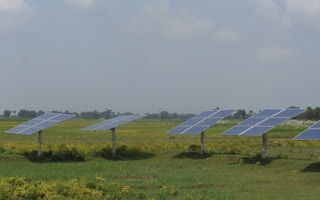For the first time, capacity addition in renewable energy in 2015 saw more than double the investment than in coal and natural gas-fired electricity generation, the United Nations Environment Programme (UNEP) said in a report released March 24.
It was one of the several firsts for ecofriendly energy, according to Global Trends in Renewable Energy Investment 2016, the 10th edition of UNEP’s annual report, which was launched by the Frankfurt School-UNEP Collaborating Centre for Climate & Sustainable Energy Finance and Bloomberg New Energy Finance.
The annual global investment of USD 266 billion in new renewables capacity was more than double the estimated USD 130 billion invested in coal and gas power stations in 2015, the report said.
Investments in renewables, including early-stage technology and R&D as well as spending on new capacity, totalled USD 286 billion in 2015, about 3% higher than the previous record in 2011. Significantly, developing world investments in renewables topped those of developed nations for the first time in 2015.
Helped by declining generating costs per megawatt-hour, particularly in the solar photovoltaic cell sector, renewables excluding large hydro made up 54% of the added gigawatt capacity of all technologies last year. It marks the first time new installed renewables have topped the capacity added from all conventional technologies.
“Renewables are becoming ever more central to our low-carbon lifestyles, and the record-setting investments in 2015 are further proof of this trend,” UNEP Executive Director Achim Steiner said in a statement.
Developing world takes lead
For the first time, investments in renewable energy in emerging economies (USD 156 billion, up 19 per cent compared with 2014) surpassed those in developed countries (USD 130 billion, down 8 per cent from a year ago), UNEP said. Much of these record-breaking investments took place in China (up 17 per cent to USD 102.9 billion, or 36 per cent of the global total).
India retuned a stellar performance in 2015 as there was a jump in utility-scale solar financings to USD 4.6 billion, up 75 per cent compared with the previous year, although a little below the 2011 record of USD 4.9 billion. Among the big projects that received financial approval were the 250MW NTPC Kadiri PV plant phase one by the country’s largest state-owned power utility, and the 200MW Adani Ramanathapuram PV installation by India’s biggest private sector electricity company.
The country has a 2022 solar target of 100GW, equivalent to some 12GW per year on average, far above its 2015’s installation level of around 3GW, UNEP said.
India’s progress in this regard is actually better than UNEP’s numbers reveal, according to Arunabha Ghosh, Chief Executive Officer of the Council on Energy, Environment and Water, a New Delhi-based policy research institution.
“The annual solar capacity additions will grow exponentially year-on-year, rather than at a flat 12GW addition per year,” Ghosh predicted. “Based on the current tendering, a total of 15.1 GW has already been tendered by January 31, 2016, with an additional 4.4 GW to be commissioned by March 31, 2016. On average, our installed solar capacity has to double every 18 months,” he said.
Srinivas Krishnaswamy, Chief Executive Officer of Vasudha Foundation, a New Delhi-based non-profit organization focusing on green energy, echoed the optimism. “In my view, the target of 12 GW per year is very much feasible. The reason for my belief is in view of the various new programmes of the government that include the electricity distribution utility finance rehabilitation programme (UDAY), the smart city programme, which also has solar rooftops as one of the priority areas; all these in addition to the 175 GW additional RE target by 2022.”
Declining costs for solar projects
Capital costs for solar projects have declined dramatically in the country to some USD 1.1 million per MW, which is among the cheapest in the world. In January 2016, an auction in Rajasthan for 420MW of capacity produced winners at tariffs of just six US cents per kWh.
Experts are divided in their view on whether such low prices are sustainable. “This dramatic decline in solar tariffs might not last for long, and at some point of time, will become more realistic, other things being the same,” Krishnaswamy said.
“For example, in a number of low tariff bids, the reason for companies being in a position to do so is largely because of getting land on lease at negligible or no costs, getting certain costs associated with wheeling and transmission waived off etc.”
“The declining tariffs are a function of several variables such as declining prices of both panels and balance of systems, economies of scale as total solar capacity increased, policy certainty and improved access to finance,” Ghosh said.
“While the declining tariffs are encouraging, the timely honouring of PPAs (power purchase agreements) and the terms of finance at which developers borrow will have to improve in order to further bring down tariffs. Decline in capital costs alone will not be the main driver of falling tariffs in the future.”
Project development times have been longer than expected in India of late, and some wind developers have diversified into solar, perhaps seeing a bigger opportunity there, the UNEP report said. It also predicted that there could be a rush in the wind sector in 2016 as accelerated depreciation and generation-based incentives would expire in March 2017.
In wind, the USD 4.1 billion of asset finance in 2015 was up 17 per cent on the previous year but below the USD 5 billion-plus figures of 2010 and 2011. One of the largest projects financed was the Hero Andhra Pradesh project, at 150MW, but there were a sizeable number of others both sides of the 100MW mark, the report said.










